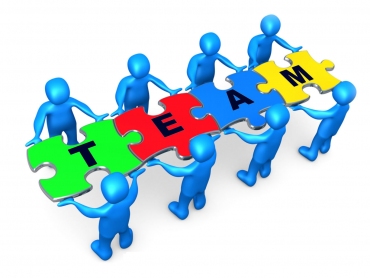Team development is an important part of effective management. A group of people, strangers aside from the fact that they work together, cannot be expected to work as a well-oiled machine immediately.
The five stages of team development will help you create and sustain a productive team working environment.
Building
The first stage of team development is building, which is when the members of the team are made familiar with one another. Team members will start the long process of learning how to relate, both socially and professionally, to their newly designated coworkers. More often than not, professionals will be on their best behavior during this initial stage. The leader of the team should clearly state the goals for the group as a goal and for each member individually at the beginning of this stage.
Challenging
After the team is built and the leader has set down the basic expectations and roles everyone is to fill, the next stage is challenging. This stage is especially prevalent if one or more team members have never worked under the supervision of the team leader. People have a tendency to push back against boundaries to see how much power they have in a group and how much they can get away with under the leader’s supervision.
As work begins, one team member or another may begin to raise questions as to the goal they are working toward, or the basic goal of the group project. At this stage, it is important for the group leader to reiterate the intention of the group, what is expected of their work, and what role every member plays.
Productivity
The third stage of team development is productivity, which is when the team hits its stride and does the work necessary to reach the ultimate goal. This stage usually overlaps and then, hopefully, extends beyond the second stage. As team members stop challenging the leader’s authority and settle into their roles, productivity can begin. People hit this stage at different rates, as no two people respond to new leadership in exactly the same way.
Achieving
During the fourth stage of team development all of the work done by individual team members comes together and the goal of the project is achieved. At this point, team leaders can take a step back from directly managing every task because team members have found a comfortable and reliable working pace.
The Ending
The end of any team project can be both positive and negative. At this stage, team members will feel proud of the completed work and potentially excited for whichever project is coming next. There will also be a bit of hesitance to leave the familiar working environment of the current team or sadness that they will be spending less time with one or more fellow team members.
Leaders should use this stage as an opportunity to congratulate and celebrate the team’s successes as a way of lessening the negative aspect of ending a team project.
The five stages of team development can be used as tools that strengthen a team leader’s management, or as distractions that derail a project’s success. Properly navigating the stages can help a team reach the intended goal in the most effective manner possible.
*Image courtesy of freedigitalphotos.net
Carl is an experienced businessman who helps small business owners grow their companies. He is knowledgeable in building and fostering effective employee teams. He works for Motivo Performance Group in Houston, Texas.

